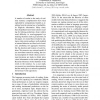Free Online Productivity Tools
i2Speak
i2Symbol
i2OCR
iTex2Img
iWeb2Print
iWeb2Shot
i2Type
iPdf2Split
iPdf2Merge
i2Bopomofo
i2Arabic
i2Style
i2Image
i2PDF
iLatex2Rtf
Sci2ools
ACL
2010
2010
A Rational Model of Eye Movement Control in Reading
A number of results in the study of realtime sentence comprehension have been explained by computational models as resulting from the rational use of probabilistic linguistic information. Many times, these hypotheses have been tested in reading by linking predictions about relative word difficulty to word-aggregated eye tracking measures such as go-past time. In this paper, we extend these results by asking to what extent reading is well-modeled as rational behavior at a finer level of analysis, predicting not aggregate measures, but the duration and location of each fixation. We present a new rational model of eye movement control in reading, the central assumption of which is that eye movement decisions are made to obtain noisy visual information as the reader performs Bayesian inference on the identities of the words in the sentence. As a case study, we present two simulations demonstrating that the model gives a rational explanation for between-word regressions.
ACL 2010 | Computational Linguistics | Eye Movement | Eye Movement Decisions | Probabilistic Linguistic Information |
| Added | 10 Feb 2011 |
| Updated | 10 Feb 2011 |
| Type | Journal |
| Year | 2010 |
| Where | ACL |
| Authors | Klinton Bicknell, Roger Levy |
Comments (0)

